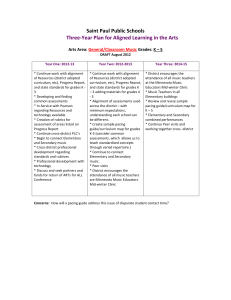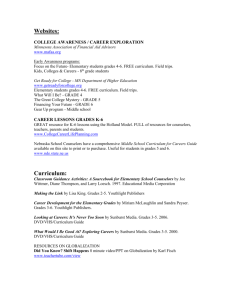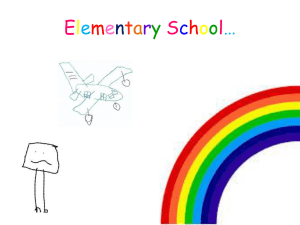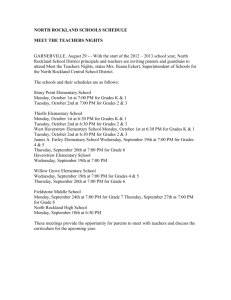Science Fair Information - Wahl
advertisement
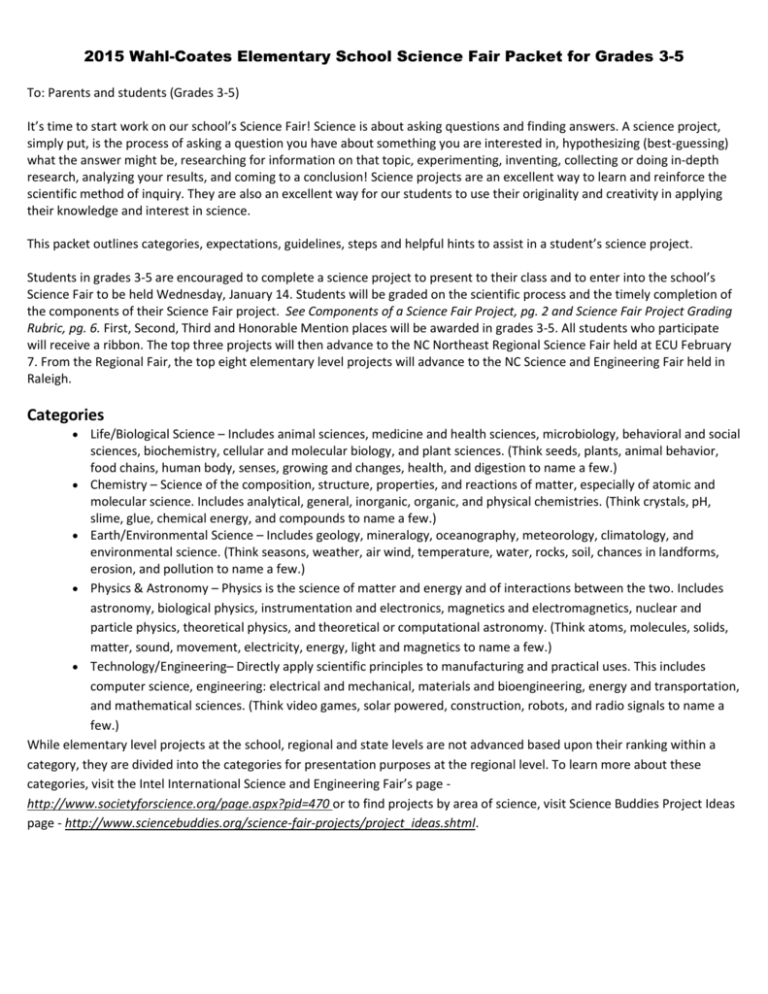
2015 Wahl-Coates Elementary School Science Fair Packet for Grades 3-5 To: Parents and students (Grades 3-5) It’s time to start work on our school’s Science Fair! Science is about asking questions and finding answers. A science project, simply put, is the process of asking a question you have about something you are interested in, hypothesizing (best-guessing) what the answer might be, researching for information on that topic, experimenting, inventing, collecting or doing in-depth research, analyzing your results, and coming to a conclusion! Science projects are an excellent way to learn and reinforce the scientific method of inquiry. They are also an excellent way for our students to use their originality and creativity in applying their knowledge and interest in science. This packet outlines categories, expectations, guidelines, steps and helpful hints to assist in a student’s science project. Students in grades 3-5 are encouraged to complete a science project to present to their class and to enter into the school’s Science Fair to be held Wednesday, January 14. Students will be graded on the scientific process and the timely completion of the components of their Science Fair project. See Components of a Science Fair Project, pg. 2 and Science Fair Project Grading Rubric, pg. 6. First, Second, Third and Honorable Mention places will be awarded in grades 3-5. All students who participate will receive a ribbon. The top three projects will then advance to the NC Northeast Regional Science Fair held at ECU February 7. From the Regional Fair, the top eight elementary level projects will advance to the NC Science and Engineering Fair held in Raleigh. Categories Life/Biological Science – Includes animal sciences, medicine and health sciences, microbiology, behavioral and social sciences, biochemistry, cellular and molecular biology, and plant sciences. (Think seeds, plants, animal behavior, food chains, human body, senses, growing and changes, health, and digestion to name a few.) Chemistry – Science of the composition, structure, properties, and reactions of matter, especially of atomic and molecular science. Includes analytical, general, inorganic, organic, and physical chemistries. (Think crystals, pH, slime, glue, chemical energy, and compounds to name a few.) Earth/Environmental Science – Includes geology, mineralogy, oceanography, meteorology, climatology, and environmental science. (Think seasons, weather, air wind, temperature, water, rocks, soil, chances in landforms, erosion, and pollution to name a few.) Physics & Astronomy – Physics is the science of matter and energy and of interactions between the two. Includes astronomy, biological physics, instrumentation and electronics, magnetics and electromagnetics, nuclear and particle physics, theoretical physics, and theoretical or computational astronomy. (Think atoms, molecules, solids, matter, sound, movement, electricity, energy, light and magnetics to name a few.) Technology/Engineering– Directly apply scientific principles to manufacturing and practical uses. This includes computer science, engineering: electrical and mechanical, materials and bioengineering, energy and transportation, and mathematical sciences. (Think video games, solar powered, construction, robots, and radio signals to name a few.) While elementary level projects at the school, regional and state levels are not advanced based upon their ranking within a category, they are divided into the categories for presentation purposes at the regional level. To learn more about these categories, visit the Intel International Science and Engineering Fair’s page http://www.societyforscience.org/page.aspx?pid=470 or to find projects by area of science, visit Science Buddies Project Ideas page - http://www.sciencebuddies.org/science-fair-projects/project_ideas.shtml. Project Guidelines 1. All projects should be of an experimental nature and follow the scientific process. Students should seek an answer to an original question rather than set up a display, model or demonstration. (Projects on dinosaurs, volcanoes and solar systems, demonstrations, and displays are not allowed.) 2. Projects involving culturing of Microorganisms will be disqualified. 3. A qualified adult should supervise experimental procedures with animals. Experiments which involve diets deficient in essential nutrients, discomforts, pain or death will be disqualified. No animals (live or preserved) should be brought to the fair. Snapshots or drawings may be submitted. 4. Dangerous items associates with a student’s project are not allowed in the Science Fair, including: syringes, toxic, caustic, flammable or explosive chemicals, bacterial cultures (of any kind) or human parasites, or high voltage/amperage electrical equipment. 5. All projects should be free standing. See Display Information, pg. 5. 6. Students must also turn in a research paper and journal. See Components of a Science Fair Project below. 7. We strongly encourage parental support, supervision and mentoring. However, Science Fair projects should be the work of the student. Students are encouraged to rely on their own creativity. 8. There are unlimited possibilities for exceptional projects conducted using inexpensive or even homemade equipment and instruments. We ask that all students limit the cost of their project materials to $10 or less, not including the cost of the display board, if possible. Helpful Hints 1. Do not wait until the last minute to put your project together. A sound project takes planning and synthesis. 2. Plan it out. It will be much more fun if you spread the time out over several days per week or several weekends, and you won’t have to race to get it done! 3. Check with your parent or teacher if you want to use a web site for research. Not all web sites give correct information. 4. Use your research journal to keep your project organized. Keep all of your notes in it. Components of a Science Fair Project 1. Display or Backdrop Exhibit: This free-standing display contains each component of the Scientific Method. See Display Information, pg. 5. 2. Research paper with bibliography: Students should write a short report (about one-half to one page) giving background facts, definitions of key vocabulary, and other information that the student used to understand his project. See Research Paper, pg. 4. 3. Oral presentation: A three to five minute presentation to the classroom. Students should be prepared to answer the questions posed by their peers regarding their project. 4. Research Journal/Notebook: Notebook contains all of your research notes, data collection, and references. You can use a spiral notebook, a folder with brads, or a 3-ring binder. 5. Model, equipment or materials used (when applicable): This should be set up in front of the display for judging. Steps in Preparing a Science Project 1. Select a TOPIC of interest. Think about what interests you. Research! Brainstorm! Ask Questions! There is a wealth of information in library books and from internet sites. See Resources, pg. 4. 2. RESEARCH what you need to know about the topic in order to formulate a question. Begin a research journal that includes everything you do for your research. Record dates for each entry. Research, read, watch science videos, contact resource people who may help. Incorporate prior knowledge. Write out your background information and research on one page for reference. Don’t forget to write down your sources for your bibliography. See Research Paper and Bibliography Format, pgs. 4 & 5. 3. State your QUESTION (in measurable terms). a. The Question is also referred to as the PROBLEM or the PURPOSE. A good question is the key to a good science fair project. Scientists ask questions and then conduct experiments to find out the answer. Therefore, the question asked, should only be able to be answered by performing an experiment, not by looking in a book. 2013 Wahl-Coates Elementary School Science Fair Packet for Grades 3-5 2 4. 5. 6. 7. 8. 9. 10. 11. b. Be specific when writing a question. For example: Instead of asking – How do bean plants grow? Ask: Does the amount of water effect how tall a bean plant will grow? State your HYPOTHESIS (what you think the answer is using words from the question). a. The HYPOTHESIS is another name for a PREDICTION. When you are writing the hypothesis you are trying to predict the answer to your question. You should always give a reason for your prediction either from your own experiences or from research you have done. b. For example: Question: Does soaking the bean seed before planting it affect how fast it will grow? Possible Predictions: I think that bean plants that have their seeds soaked before planting will grow faster because it will make the hard seed covering soft. OR I do not think that soaking the beans will make the bean plant grow faster because soaking the seed will just make the seed mushy. Make a list of MATERIALS needed. Be specific to size, amount needed, type or brand and use metric measurements. Determine the VARIABLE being tested and the conditions that you need to CONTROL. a. Take time to identify your variables before you start your experiment. It will help you to write your procedures. Variable is something that can change or be changed. There are three kinds of variables called, independent, dependent and controlled variables. In a well-designed investigation there should be only one thing changed on purpose, called the independent or manipulated variable. What you think or hope will change during the experiment is called the dependent variable or responding variable. You must try to keep any other things that might be changed the same throughout the experiment. These things that you keep the same are called the controlled variables. Write out the PROCEDURE. What steps will you take to solve the problem? The procedure should be complete, clearly written, and listed in numerical order. a. PROCEDURES are a detailed step-by-step set of directions of how to conduct the experiment. Details are very important here. Be sure to tell exact amounts of things such as materials, time it will take, etc. It is important that anyone be able to follow your steps and repeat your experiment exactly as you did it. You MUST have at least 3 repeated trials and clearly identify what you are keeping the same and what you are changing (variables) to ensure a well-designed investigation. Set up DATA COLLECTION framework. a. Before you start conducting your experiment, it is important that you have thought out your data collection. To begin, you should design a chart, table, or journal entry system to record your information. Whenever possible, you must collect NUMERICAL DATA in a chart or table because you are expected to provide both a graph and written results for your project. Your chart or table should have room for repeated trials (no less than three - the more trials you complete, the more reliable your data and conclusion) and a place to find the average (mean) of your data. The data should be collected using metric units whenever possible because metric is the international system of measurement for scientists. Metric units include centimeters, meters (linear), grams (weight/mass), and liters (liquid volume). Neatness will help you to keep accurate data. Label the different rows and columns of your chart or table. Also include a title. Be sure to keep all data collection methods in your research journal. You may create computer generated graphs/charts/tables from your data if you would like. CONDUCT the experiment or test. Take pictures, if appropriate. a. To conduct the experiment you will need to: follow the procedures just as you wrote them; keep accurate records by filling in your data chart and making journal entries as you go; have all the materials gathered together before you begin. OBSERVE and RECORD results in your data chart. Then convert your data into a graph to make it easier to interpret your results. ANALYZE your data and write RESULTS. What kinds of relationships were found between the variable and control? What was the same/different? Did you see any patterns in the data? a. All RESULTS should include three parts. First, it should include a data chart. An appropriate graph (line, pie or bar) of the data collected in the chart should also be included. Finally, a written explanation of the chart information and the graph. The written explanation should be at least a paragraph long. Results may also include photographs and diagrams that help to display and understand the data. Results are not the conclusion. It is simply a summary of what the data shows. 2013 Wahl-Coates Elementary School Science Fair Packet for Grades 3-5 3 12. Draw CONCLUSION. Was your hypothesis correct or incorrect? What was the answer to your question? (Support with data collected.) Were there any problems with the investigation or things I would do differently? What other things would I like to investigate about my topic? How does what I learned apply to the real world? a. The CONCLUSION tells what you learned about the topic by completing the experiment. It contains many parts. Answer each of the questions above. Then join them together in paragraph form to write your conclusion. 13. ORGANIZE your display. Label each part clearly and neatly. See Display Information, pg. 5. 14. PREPARE for the classroom oral presentation. Be able to answer the questions like: Why did you select this project? How you did it? What you found out. Was this a good project? What do you think you might have done differently? Resources This is just a couple of web sites to help get your science fair cap on. NC Science and Engineering Fair – Official Site o http://www.ncsciencefair.org/ Science Buddies – Great for guiding students through the steps of developing a research project. o http://www.sciencebuddies.org/ Cool Science Projects – Tips for creating award-winning science fair projects. o http://www.cool-science-projects.com Steven Spangler Science – Entertaining videos of experiments to spark your own project. o http://www.stevespanglerscience.com/experiments/ DragonflyTV – Videos of experiments with accompanying variation ideas for home experiments. o http://pbskids.org/dragonflytv/scifair/index.html Discovery Education’s Science Fair Central – Resources on projects, display boards, and getting started. o http://school.discoveryeducation.com/sciencefaircentral/ Research Paper Research is important to a good science fair project. It helps you to choose a topic and then learn more about the topic. The research paper is not complicated and need only include the following five things: 1. Title Page – The title page includes the title of your project, your name, school, grade, teacher and the date the project is being turned in. 2. Acknowledgements – A personal thank you to anyone who helped you with the project (teacher, parent, sibling, scientist, librarian, etc.) 3. Question – The specific question you asked for your experiment 4. Background Research – Use the books in the library and the Internet to find out interesting and relevant information about your topic. Rewrite the information you find in your own words. Do not just copy from the book or print out pages from the Internet. This is considered PLAGARISM and it is illegal. If you are having difficulty putting ideas in your own words, try saying aloud a small section that you have just read without looking, chances are you will put it in your own words or ask an adult to help you. Be sure to include definitions of key vocabulary. Keep track of what books or websites you used to get your information so you can list your sources in a bibliography. 5. Sources/Bibliography – An alphabetical listing of books, articles or other sources including websites that you used when researching your topic. 2013 Wahl-Coates Elementary School Science Fair Packet for Grades 3-5 4 Bibliography Format Entries in a bibliography are alphabetized by the last name of the author or the first word of the title. An entry for which the author is unknown, such as a newspaper article or an unsigned review, is alphabetized by the first word of the title, excluding the articles A, An, and The. Books Basic Form Two Authors Bronowski, Jacob. The Ascent of Man. Boston: Little & Brown, 1973. March, James G., and Herbert A. Simon. Organizations. New York: Wiley, 1958. Magazines Weekly Monthly Tuchman, Barbara W. “The Decline of Quality.” New York Times Magazine, 2 Nov. 1980: 38-57. Brown, Norman O. “Apocalypse: The Place of Mystery in the Life of the Mind.” Harper’s. May 1961: 27-35. Newspapers Basic Entry Kristof, Nicholas D. “Oil Futures Plunge on OPEC Doubt.” New York Times, 3 Jan. 1985: Dl3. Reference Works Encyclopedia Entry, Unsigned Dictionary Entry “Huygens, Christiaan.” Encyclopedia Britannica. 13th ed. “Advertisement.” Webster’s Third International Dictionary. (Because the number of the edition appears in the title, the date is not necessary.) Atlas Entry “Hidden Face of the Moon.” Times Atlas of the World. 1981 ed. Nonprint Sources Video Redford, Robert, dir. Ordinary People. With Mary Tyler Moore and Donald Sutherland. Paramount, 1980. Computer Materials Computer Software Web Sites Visispell: Fut.heuristix. Version 1.00. Computer software. San Jose: Visicorp, 1983. Disk. Corte, Corrinne. “Why Are British Sailors Called Limeys?” Ask A Biologist. 2000. Arizona State University. 8 Mar. 2001. http://ls.la.asu.edu/askabiologist/research/scurvy/index.html Interview Persons name (last name first), position or work title, place of interview, date of interview. Display Information 1. Display board must be sturdy and stand by itself on a table. Foam core-board and cardboard are the best materials. Display boards can be purchased at stores like Office Depot, Staples, Michael’s, Wal-Mart and Target. They may be white or colored. Used boards may be recovered or painted and used again. 2. Projects will be required to meet the standards for the Regional Science Fair: 48 inches wide (side to side), 30 inches deep (front to back) and 78 inches in height (front table top to top of display) or 108 inches in height (floor to top of display). 3. No names are allowed on the front of the projects. 4. Do not use pins, tacks, staples or tape. Use glue/rubber cement rather than tape to affix items to display board, if possible. 5. Drawings and photos are most useful on the display. Drawings should be drawn in pencil first and then retraced. Drawings should be in color and outlined in thin black felt tip pen. Graphs and charts must be used in the results section. They may be computer-generated. All graphs and charts must have explanatory titles. Graph axes must be labeled. If you have a camera, you should photograph your experiment’s progress. Pictures can be used but should not be full-face shots. All photos must be titled. 6. Be neat. 7. Make it colorful, using colors that are appropriate to the topic. Use colors to attract attention but don’t overdo it. Too much color can be distracting. Try to use no more than three colors except for special situations. 8. Titles should be short, catchy, and related to the project idea. 9. Writing should be neat and legible. If you choose to use a computer, stick to one or two fonts to type your work. 10. Spelling does count. Take time to check over your work before you put it on your display board. 11. Practice your layout. Before you begin gluing things down, practice moving the parts of the display around until they are evenly spaced and centered. 2013 Wahl-Coates Elementary School Science Fair Packet for Grades 3-5 5 12. Don’t glue on materials from your project. Don’t glue on food items such as M&M’s, popcorn or moldy bread to the board. Not only do they attract bugs but they are not allowed. Use photographs or drawings instead. Example of a Display This is just one example of a possible display board layout. Note the Research Journal and Research Paper displayed on the table. Problem or Question Hypothesis Materials Project Title Procedure 1. 2. 3. 4. 5. Independent, Dependent, and Controlled Variables Photos, 1. Diagrams, Data Charts, or Graphics 2. Results Written Explanation of the Results Conclusion 3. 4. Research Journal 5. Research Paper Fair Judging Criteria 1. Creative Ability: Does the project show originality of thinking and investigation of an original idea? 2. Scientific Thought: Does the project show evidence of well-organized work, use of the scientific method in investigating and solving the problem, and are concepts and investigations clearly demonstrated? Is the student knowledgeable about the process and project? Can the student answer questions about the process and project? 3. Skill and Thoroughness: Does the project show evidence of careful workmanship, and a clearly organized presentation of the steps taken in conducting the investigation and presenting the results and conclusion? Does the project give a complete explanation of the principle or process involved? 4. Clarity and Dramatic Presentation: Is the project presented in a manner that is easily understood, with an attractive layout that commands the attention of viewers with a clearly defined and well-labeled display? Science Fair Project Grading Rubric Scientific Method Format (on display board) Background information/pertinent research Question Hypothesis Complete Materials List Procedure-Listed by number Variable and Control Results-Chart, graph Data Analysis Conclusion Display Attractive Layout and Design Presentation Voice/Dictation/Eye Contact/Understanding of Topic Research Journal Notebook Total 2013 Wahl-Coates Elementary School Science Fair Packet for Grades 3-5 Possible Points 5 5 5 10 10 10 10 10 10 5 5 7.5 7.5 100 Points Earned 6


